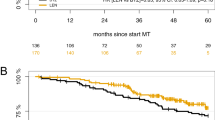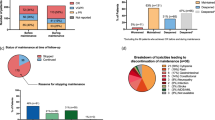Abstract
Maintenance therapy post-autologous hematopoietic cell transplantation (AHCT) with either lenalidomide or bortezomib for multiple myeloma (MM) have separately been shown to improve progression-free survival (PFS), but have never been directly compared. We performed a retrospective study to investigate progression-free and overall survival outcomes and toxicities of lenalidomide maintenance therapy compared with bortezomib maintenance in MM patients post-AHCT. This study included 156 patients who received post-AHCT lenalidomide or bortezomib maintenance therapy for MM. The primary outcome was PFS. Ninety-two patients received lenalidomide maintenance and 64 received bortezomib maintenance post-AHCT. By multivariable analysis, maintenance therapy choice and cytogenetics risk did not impact PFS or OS. Staging by International Staging System and pre-maintenance disease response were the greatest predictors for PFS. Treatment-related toxicities were as anticipated with 5.4% of patients receiving maintenance lenalidomide experiencing secondary primary malignancies (SPMs) compared with 3% for bortezomib. These findings suggest there were no differences in PFS or OS between lenalidomide and bortezomib maintenance therapy options for post-transplantation MM patients. These data should be validated in a larger, prospective cohort to determine if maintenance choice should be guided by side effect profile and patient anticipated tolerance rather than by disease biology alone.
This is a preview of subscription content, access via your institution
Access options
Subscribe to this journal
Receive 12 print issues and online access
$259.00 per year
only $21.58 per issue
Buy this article
- Purchase on Springer Link
- Instant access to full article PDF
Prices may be subject to local taxes which are calculated during checkout

Similar content being viewed by others
References
Palumbo A, Cavallo F, Gay F, Di Raimondo F, Ben Yehuda D, Petrucci MT, et al. Autologous transplantation and maintenance therapy in multiple myeloma. N Engl J Med. 2014;371:895–905.
Child JA, Morgan GJ, Davies FE, Owen RG, Bell SE, Hawkins K, et al. High-dose chemotherapy with hematopoietic stem-cell rescue for multiple myeloma. N Engl J Med. 2003;348:1875–83.
Attal M, Lauwers-Cances V, Hulin C, Leleu X, Caillot D, Escoffre M, et al. Lenalidomide, bortezomib, and dexamethasone with transplantation for myeloma. N Engl J Med. 2017;376:1311–20.
Jacobs RW, Saliba RM, Sasaki K, Farhan S, Armas A, Shah ND, et al. Outcome of patients with nonsecretory multiple myeloma after autologous hematopoietic stem cell transplantation. Clin Lymphoma Myeloma Leuk. 2016;16:36–42.
Djulbegovic B, Kumar A. Multiple myeloma: detecting the effects of new treatments. Lancet. 2008;371:1642–4.
Pulte D, Redaniel MT, Brenner H, Jansen L, Jeffreys M. Recent improvement in survival of patients with multiple myeloma: variation by ethnicity. Leuk Lymphoma. 2014;55:1083–9.
Sonneveld P, Goldschmidt H, Rosiñol L, Bladé J, Lahuerta JJ, Cavo M, et al. Bortezomib-based versus nonbortezomib-based induction treatment before autologous stem-cell transplantation in patients with previously untreated multiple myeloma: a meta-analysis of phase III randomized, controlled trials. J Clin Oncol. 2013;31:3279–87.
Kumar SK, Lacy MQ, Dispenzieri A, Buadi FK, Hayman SR, Dingli D, et al. Early versus delayed autologous transplantation after immunomodulatory agents-based induction therapy in patients with newly diagnosed multiple myeloma. Cancer. 2012;118:1585–92.
Gay F, Larocca A, Wijermans P, Cavallo F, Rossi D, Schaafsma R, et al. Complete response correlates with long-term progression-free and overall survival in elderly myeloma treated with novel agents: analysis of 1175 patients. Blood. 2011;117:3025–31.
Cornell RF, Kassim AA. Evolving paradigms in the treatment of relapsed/refractory multiple myeloma: increased options and increased complexity. Bone Marrow Transplant. 2016;51:479–91.
Clark CA, Cornell RF, Scott EC, Chung J, Costa LJ. Management of relapsed and refractory multiple myeloma in modern times: incorporating new agents into decision-making. Am J Hematol. 2016;91:1044–51.
Barlogie B, Tricot GJ, Van Rhee F, Angtuaco E, Walker R, Epstein J, et al. Long-term outcome results of the first tandem autotransplant trial for multiple myeloma. Br J Haematol. 2006;135:158–64.
Palumbo A, Mina R, Cerrato C, Cavallo F. Role of consolidation/maintenance therapy in multiple myeloma. Clin Lymphoma Myeloma Leuk. 2013;13:S349–S54.
Facon T. Posttransplantation maintenance in patients with multiple myeloma. Clin Lymphoma Myeloma. 2009;9:S55–S6.
Attal M, Lauwers-Cances V, Marit G, Caillot D, Moreau P, Facon T, et al. Lenalidomide maintenance after stem-cell transplantation for multiple myeloma. N Engl J Med. 2012;366:1782–91.
McCarthy PL, Owzar K, Hofmeister CC, Hurd DD, Hassoun H, Richardson PG, et al. Lenalidomide after stem-cell transplantation for multiple myeloma. N Engl J Med. 2012;366:1770–81.
Kagoya Y, Nannya Y, Kurokawa M. Thalidomide maintenance therapy for patients with multiple myeloma: meta-analysis. Leuk Res.2012;36:1016-21.
Attal M, Harousseau J-L, Leyvraz S, Doyen C, Hulin C, Benboubker L, et al. Maintenance therapy with thalidomide improves survival in patients with multiple myeloma. Blood. 2006;108:3289–94.
Berenson JR, Crowley JJ, Grogan TM, Zangmeister J, Briggs AD, Mills GM, et al. Maintenance therapy with alternate-day prednisone improves survival in multiple myeloma patients. Blood. 2002;99:3163–68.
Sahebi F, Spielberger R, Kogut NM, Fung H, Falk PM, Parker P, et al. Maintenance thalidomide following single cycle autologous peripheral blood stem cell transplant in patients with multiple myeloma. Bone Marrow Transplant. 2006;37:825–9.
Sonneveld P, Schmidt-Wolf IG, van der Holt B, El Jarari L, Bertsch U, Salwender H, et al. Bortezomib induction and maintenance treatment in patients with newly diagnosed multiple myeloma: results of the randomized phase III HOVON-65/ GMMG-HD4 trial. J Clin Oncol. 2012;30:2946–55.
Palumbo A, Hajek R, Delforge M, Kropff M, Petrucci MT, Catalano J, et al. Continuous lenalidomide treatment for newly diagnosed multiple myeloma. N Engl J Med. 2012;366:1759–69.
Lipe B, Vukas R, Mikhael J. The role of maintenance therapy in multiple myeloma. Blood Cancer J. 2016;6:e485.
Cornell RF, D’Souza A, Kassim AA, Costa LJ, Innis-Shelton RD, Zhang MJ, et al. Maintenance versus induction therapy choice on outcomes after autologous transplantation for multiple myeloma. Biol Blood Marrow Transplant. 2017;23:269–77.
Facon T. Maintenance therapy for multiple myeloma in the era of novel agents. Hematol Am Soc Hematol Educ Program. 2015;2015:279–85.
Mikhael JR, Dingli D, Roy V, Reeder CB, Buadi FK, Hayman SR, et al. Management of newly diagnosed symptomatic multiple myeloma: updated Mayo Stratification of Myeloma and Risk-Adapted Therapy (mSMART) consensus guidelines 2013. Mayo Clin Proc. 2013;88:360–76.
Anderson KC, Alsina M, Atanackovic D, Biermann JS, Chandler JC, Costello C, et al. Multiple myeloma, version 2.2016: clinical practice guidelines in oncology. J Natl Compr Canc Netw. 2015;13:1398–435.
Rajkumar SV. Multiple myeloma: 2012 update on diagnosis, risk-stratification, and management. Am J Hematol. 2012;87:78–88.
Kumar S, Paiva B, Anderson KC, Durie B, Landgren O, Moreau P, et al. International Myeloma Working Group consensus criteria for response and minimal residual disease assessment in multiple myeloma. Lancet Oncol. 2016;17:e328–46.
Core Team R. R: a language and environment for statistical computing. Vienna, Austria: R Core Team; 2015. Version 3.2.3.
Musto P, Anderson KC, Attal M, Richardson PG, Badros A, Hou J, et al. Second primary malignancies in multiple myeloma: an overview and IMWG consensus. Ann Oncol. 2017;28:228–45.
Areethamsirikul N, Reece DE. The risk of secondary primary malignancies after therapy for multiple myeloma. Leuk Lymphoma. 2015;56:3012–21.
Schecter JM, Lentzsch S. Risk of secondary primary malignancies in maintenance therapy for multiple myeloma. Int J Hematol Oncol. 2013;2:339–47.
Jones JR, Cairns DA, Gregory WM, Collett C, Pawlyn C, Sigsworth R, et al. Second malignancies in the context of lenalidomide treatment: an analysis of 2732 myeloma patients enrolled to the Myeloma XI trial. Blood Cancer J. 2016;6:e506.
Moreau P, Pylypenko H, Grosicki S, Karamanesht I, Leleu X, Grishunina M, et al. Subcutaneous versus intravenous administration of bortezomib in patients with relapsed multiple myeloma: a randomised, phase 3, non-inferiority study. Lancet Oncol. 2011;12:431–40.
Ludwig H, Durie BGM, McCarthy P, Palumbo A, San Miguel J, Barlogie B, et al. IMWG consensus on maintenance therapy in multiple myeloma. Blood. 2012;119:3003–15.
Teitelbaum A, Ba-Mancini A, Huang H, Henk HJ. Health care costs and resource utilization, including patient burden, associated with novel-agent-based treatment versus other therapies for multiple myeloma: findings using real-world claims data. Oncologist. 2013;18:37–45.
LeBlanc R, Hollmann S, Tay J. Canadian cost analysis comparing maintenance therapy with bortezomib versus lenalidomide for patients with multiple myeloma post autologous stem cell transplant. J Popul Ther Clin Pharmacol. 2016;23:e103–13.
Mian I, Milton DR, Shah N, Nieto Y, Popat UR, Kebriaei P, et al. Prolonged survival with a longer duration of maintenance lenalidomide after autologous hematopoietic stem cell transplantation for multiple myeloma. Cancer. 2016;122:3831–37.
Author information
Authors and Affiliations
Corresponding author
Ethics declarations
Conflict of interest
The authors declare that they have no conflict of interest.
Rights and permissions
About this article
Cite this article
Huang, J., Phillips, S., Byrne, M. et al. Lenalidomide vs bortezomib maintenance choice post-autologous hematopoietic cell transplantation for multiple myeloma. Bone Marrow Transplant 53, 701–707 (2018). https://doi.org/10.1038/s41409-018-0177-6
Received:
Revised:
Accepted:
Published:
Issue Date:
DOI: https://doi.org/10.1038/s41409-018-0177-6
This article is cited by
-
Real world outcomes of lenalidomide or bortezomib maintenance in patients with multiple myeloma not undergoing stem cell transplantation
Annals of Hematology (2023)
-
Propensity-score matched analysis of the efficacy of maintenance/continuous therapy in newly diagnosed patients with multiple myeloma: a multicenter retrospective collaborative study of the Japanese Society of Myeloma
Journal of Cancer Research and Clinical Oncology (2022)
-
Maintenance therapy after second autologous hematopoietic cell transplantation for multiple myeloma. A CIBMTR analysis
Bone Marrow Transplantation (2022)
-
Mechanism of exosomal miR-155 derived from bone marrow mesenchymal stem cells on stemness maintenance and drug resistance in myeloma cells
Journal of Orthopaedic Surgery and Research (2021)
-
Lenalidomide versus bortezomib maintenance after frontline autologous stem cell transplantation for multiple myeloma
Blood Cancer Journal (2021)



